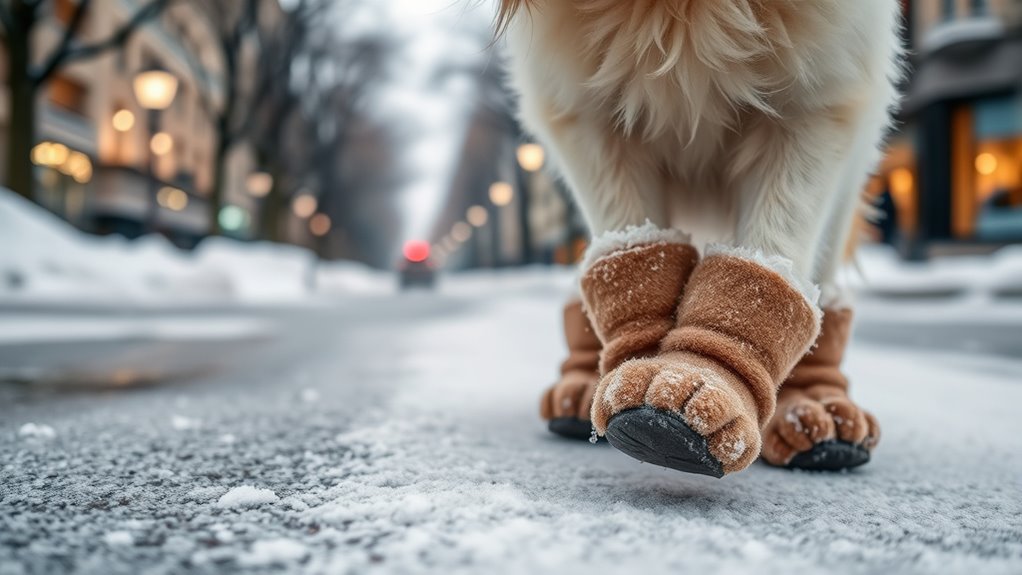In winter, protect your pet’s paws by inspecting them regularly for cracks, redness, or debris. Use paw balms, wipes, and well-fitted waterproof boots with non-slip soles to shield against ice, salt, and chemicals. Trim between toes to prevent ice buildup and limit outdoor walks during extreme cold. After each outing, clean and moisturize their paws and watch for signs of injury. Keep your pet comfortable and safe all season—there’s more you can do to guarantee their paw health.
Key Takeaways
- Regularly inspect and clean paws after walks to remove salt, chemicals, and debris, preventing irritation and infections.
- Apply paw balms or waxes before outdoor activities to create a protective barrier against cold and harsh surfaces.
- Use well-fitting waterproof boots with non-slip soles to insulate paws and improve traction on icy surfaces.
- Trim hair between paw pads to prevent ice ball buildup and debris accumulation, reducing discomfort and injury risk.
- Post-walk, thoroughly check paws for cuts or cracks and moisturize to maintain skin softness and prevent cracking.
Recognizing Common Winter Paw Problems
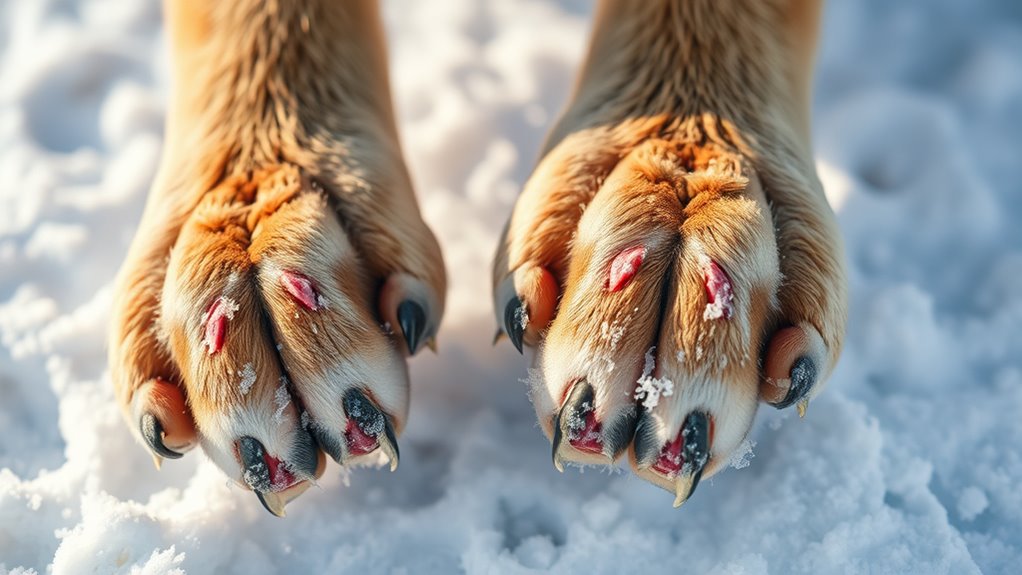
Winter can be tough on your pet’s paws, making it important to recognize common problems early. One sign to watch for is paw pad cracking, which occurs when the skin becomes dry and brittle from cold temperatures and harsh surfaces. Cracked pads can cause discomfort and increase the risk of infections. Another issue is ice ball formation, where ice gets trapped between your pet’s toes or clings to their paw pads. This can lead to pain, irritation, and difficulty walking. Regularly check your pet’s paws after walks to identify these problems promptly. If you notice cracking or ice balls, it’s vital to take action quickly to prevent further discomfort or injury. Using specialized paw balms can help protect and soothe your pet’s paws during winter. Being aware of seasonal paw care tips helps pet owners prepare effectively for winter conditions, including proper paw protection techniques. Additionally, understanding how to minimize UV radiation exposure during outdoor activities can further safeguard your pet’s skin and paws from harsh environmental factors. Applying protective clothing or paw covers can also serve as an effective paw protection method, especially in extreme weather. Recognizing these issues helps keep your pet safe and comfortable during winter months.
Preparing Your Pet’s Paws Before Going Outdoors
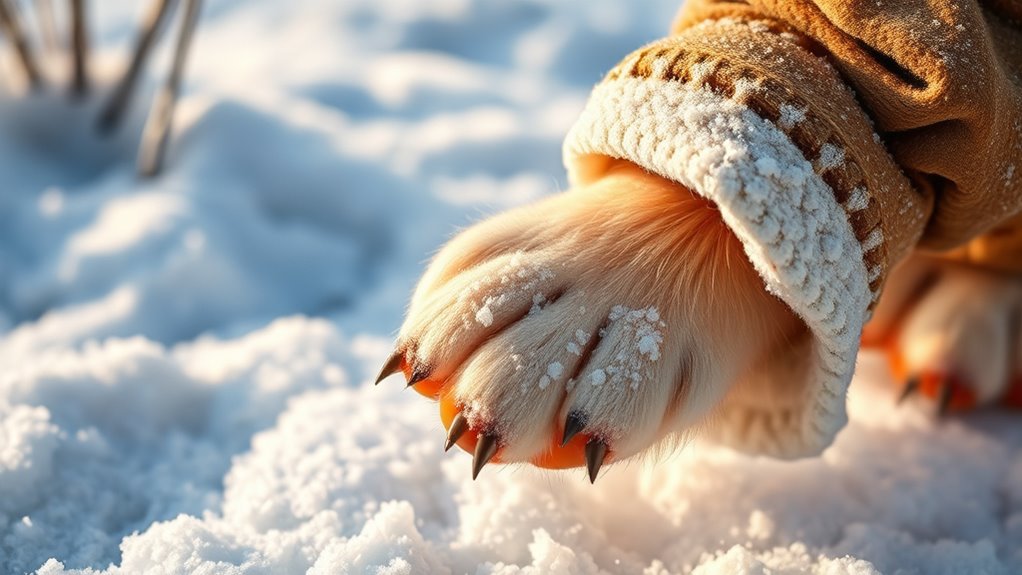
Before heading outdoors, it’s essential to prepare your pet’s paws to minimize winter-related issues. This is a key part of seasonal paw care and winter paw protection. Start by gently inspecting their paws for any debris, cracks, or redness. Trim the hair between their paw pads to prevent ice balls from forming. You can also wipe their paws with a damp cloth to remove salt or chemicals that could cause irritation. Applying a paw balm or wax before walks forms a protective barrier against cold surfaces. Ensuring your pet’s paws are clean and dry helps prevent frostbite and reduces the risk of injury. Using dog-specific paw balms that are safe and effective can provide additional protection during harsh weather conditions. Regularly monitoring your pet’s paw health allows you to detect early signs of damage or discomfort. Being aware of winter paw conditions and how to address them is crucial for maintaining your pet’s comfort. Recognizing the importance of seasonal paw care can help you implement effective strategies to keep your pet safe in winter. Taking these simple steps before outdoor adventures keeps their paws healthy and comfortable, making winter walks safer and more enjoyable for both of you. Incorporating positive action like regular paw inspections demonstrates kindness and compassion towards your pet’s well-being.
Choosing the Right Protective Gear for Cold Weather
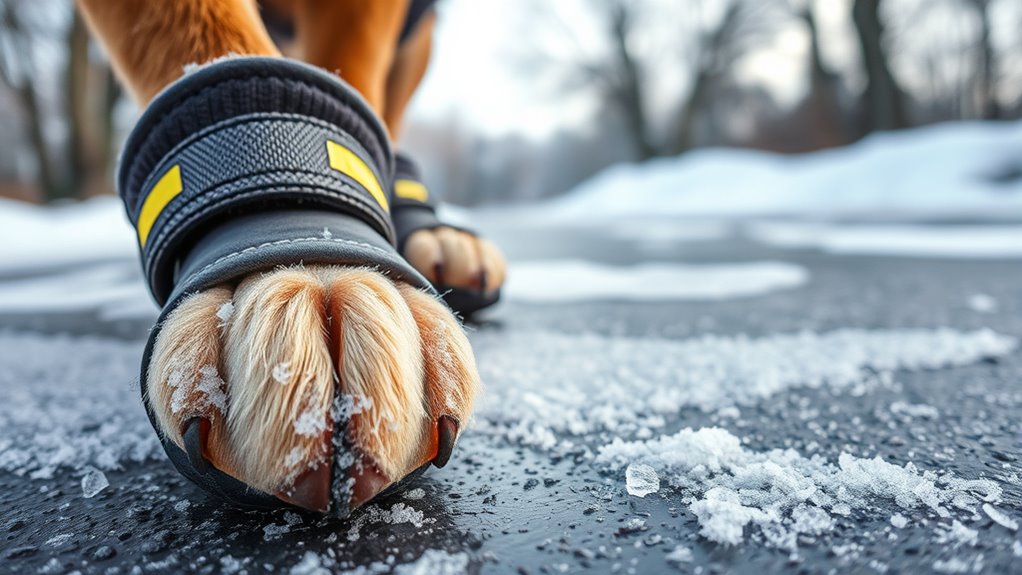
When selecting protective gear for cold weather, focus on choosing materials that keep your pet’s paws warm and dry without causing irritation. Make sure the gear fits well and feels comfortable so your pet can move freely and comfortably. Proper fit and breathable materials are key to ensuring effective protection during winter outings. Using gear with appropriate material composition can also help prevent skin irritation and enhance comfort. Incorporating sound design principles, such as selecting materials that minimize noise and discomfort, can further improve your pet’s winter experience. Additionally, choosing gear with sensor technology can help monitor your pet’s activity and health during outdoor activities.
Material Selection Tips
Choosing the right protective gear for cold weather starts with selecting materials that keep your pet’s paws warm and dry. Look for winter footwear made from waterproof and insulating materials like rubber and fleece to prevent moisture and cold from reaching their skin. Consider paw wax formulations that create a barrier against ice, salt, and chemicals, reducing irritation and injury. Here are some material tips:
- Opt for boots with durable, waterproof uppers and non-slip soles.
- Choose insulating linings like fleece or wool for extra warmth.
- Use paw wax formulations to add a protective layer before walks.
- Avoid synthetic fabrics that trap moisture or cause discomfort.
- Regularly check payment security measures to ensure your online purchases remain protected during winter shopping.
Selecting gear with these materials ensures your pet’s paws stay protected and comfortable during winter adventures.
Fit and Comfort
Ensuring your pet’s protective gear fits properly is essential for comfort and effectiveness during winter walks. Proper winter shoe fitting prevents chafing and keeps paws secure, reducing the risk of discomfort. Take time to measure your pet’s paws carefully, considering paw pad moisturization, which helps keep the skin supple and resistant to cracking. When choosing boots, look for a snug but not tight fit, allowing natural paw movement. Ill-fitting shoes can cause blisters or restrict circulation, so adjust straps and closures for a comfortable fit. Remember, paw pads are sensitive, so protective gear should support them without causing pressure. Regularly check the fit during walks, and replace gear as needed to maintain comfort and safety. Using proper installation and venting as a metaphor, ensuring a proper fit helps maintain the right moisture balance and promotes healthy paw skin. Additionally, selecting high-quality materials can enhance durability and comfort for your pet’s paws. Proper fitting also helps prevent debris and salt from accumulating between the gear and the paw, which can lead to irritation. To further protect your pet’s paws, consider the seasonal conditions and adjust gear accordingly to prevent issues caused by snow, ice, or salt.
Best Practices for Short and Long Walks in Winter
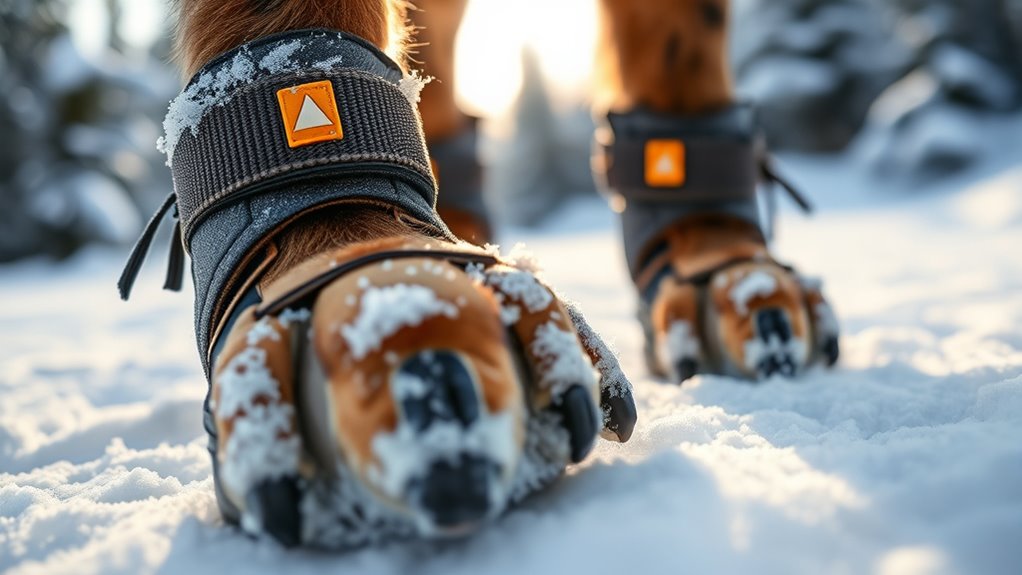
Winter walks can be enjoyable for both you and your dog, but it’s important to adapt your routine to cold conditions. To protect your dog’s paws during short and long walks, keep these practices in mind:
- Check paw pad hydration regularly to prevent cracking and dryness.
- Use well-fitted winter boots with durable soles to withstand icy terrain and provide insulation.
- Limit walk duration during extreme cold and avoid walking on salted or chemical-treated surfaces.
- Inspect paws after walks for any cuts or ice buildup, and clean them thoroughly to maintain winter boot durability and paw health.
- Applying a protective paw balm can help seal in moisture and shield paws from harsh winter elements. Additionally, choosing appropriate footwear can significantly reduce exposure to cold and rough surfaces, providing extra protection for your dog’s paws. Regularly monitor paw health to catch any issues early and ensure your dog’s paws are properly cared for during winter can prevent discomfort and injury, and using paw protection products can further enhance their resilience against winter hazards.
Following these tips guarantees your dog’s paws stay protected, hydrated, and resilient throughout the winter season.
Post-Walk Paw Care and Cleaning Tips
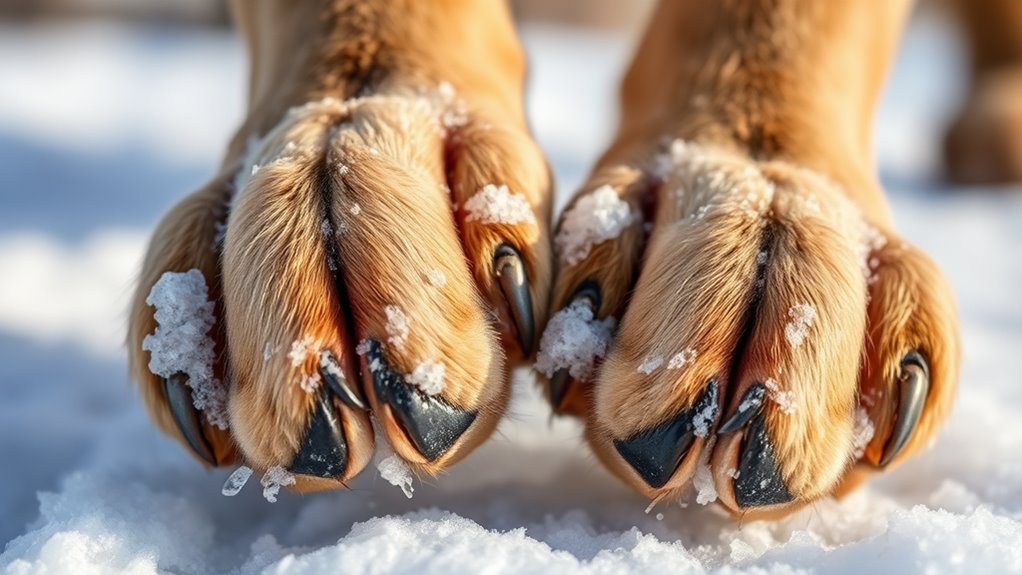
After your walk, it’s essential to clean and inspect your dog’s paws promptly to prevent irritation or injury. Gently wipe off any ice, salt, mud, or chemicals using a damp cloth or pet-safe wipes. Check for cuts, cracks, or redness, and pay special attention to the paw pads. Using a paw pad moisturizer helps keep the skin soft and prevents cracking, especially in winter’s harsh conditions. Once clean, give your dog a soothing paw massage to improve circulation and comfort. Be gentle around sensitive areas, and ensure the moisturizer is safe for pets. Regularly caring for your dog’s paws after walks not only keeps them clean but also promotes healthy, happy paws throughout the season. Proper beneficiary designation can also ensure your pet’s care is well-managed in case of unforeseen circumstances.
Signs of Paw Injury or Irritation to Watch For
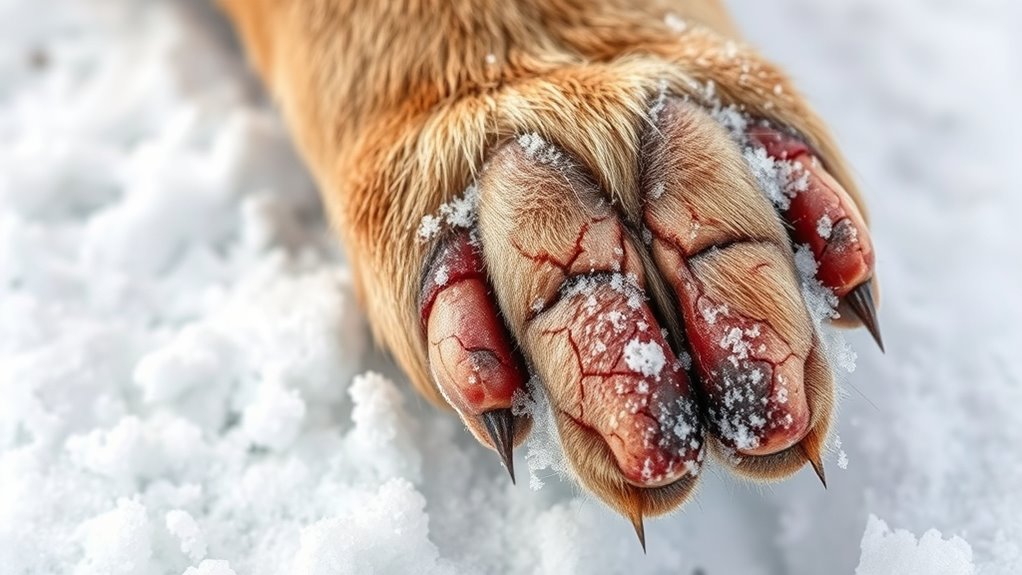
Keeping a close eye on your dog’s paws after walks helps catch early signs of injury or irritation. Watch for paw pad sensitivity, which may cause your dog to favor one paw or react when touched. Paw licking behaviors are common signs of discomfort or irritation. Also, look for redness, swelling, or cuts on the paw pads and between the toes. Excessive licking or chewing might indicate pain or irritation. You should also notice if your dog is hesitant to walk or shows signs of limping. Any signs of bleeding, blisters, or cracked paw pads should be addressed promptly. Recognizing these signs early helps prevent further injury and keeps your dog comfortable during winter walks.
When to Consult a Veterinarian for Paw Concerns
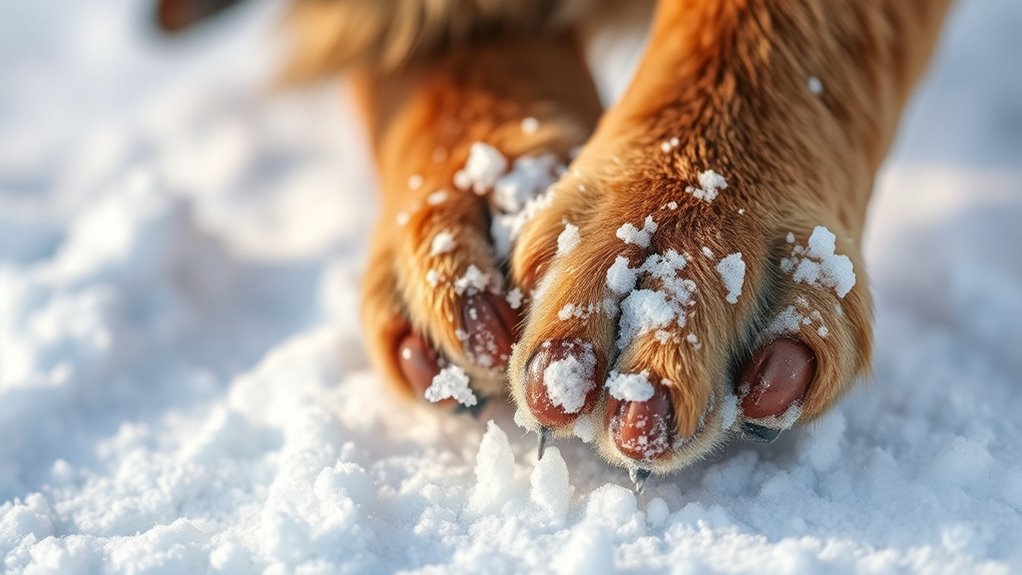
You should consult a veterinarian for paw concerns whenever you notice persistent redness, swelling, or bleeding that doesn’t improve within a day or two. Paw pad injuries, such as cuts or cracks, can become infected if left untreated, so early professional evaluation is essential. Additionally, if your dog shows signs of allergic reactions—like excessive licking, swelling, or blisters—you should seek veterinary advice promptly. A vet can properly assess the injury or allergic response, recommend appropriate treatment, and prevent complications. Don’t ignore ongoing discomfort or worsening symptoms, as untreated paw issues can lead to pain or more severe infections. Timely veterinary care guarantees your pet’s paws heal properly and reduces the risk of long-term damage.
Frequently Asked Questions
How Often Should I Trim My Dog’S Paw Hair During Winter?
You should trim your dog’s paw hair regularly to keep winter paw maintenance effective. Typically, every 4 to 6 weeks is a good rule of thumb, but it depends on how quickly their hair grows. Regular paw hair trimming prevents ice and salt buildup, reducing discomfort and potential injuries. Keep an eye on their paws, and trim as needed to make certain they stay clean, dry, and comfortable during the colder months.
Can Certain Foods Help Strengthen My Pet’S Paw Pads?
You might wonder if certain foods can reinforce your pet’s paw pads. A paw pad diet rich in healthy fats, vitamins, and minerals supports skin health. Nutritional supplements like omega-3 fatty acids can improve pad resilience and hydration. Feeding your pet high-quality, balanced meals ensures they get essential nutrients. Remember, consult your vet before adding supplements to ensure they’re safe and effective for your pet’s specific needs.
Are There Natural Remedies for Winter Paw Dryness?
Imagine your pet’s paws as tiny, delicate sponges trying to stay soft in winter’s chill. You can try natural home remedies like coconut oil or shea butter to boost paw pad hydration and soothe dryness. Regularly applying these remedies helps keep paws resilient, much like watering a garden. Remember, consistent care is key to preventing cracks and discomfort, ensuring your furry friend stays comfortable through the cold months.
How Do I Prevent Ice From Getting Stuck Between Paw Pads?
To prevent ice accumulation between your dog’s paw pads, regularly clean their paws after walks, focusing on the areas between the pads. Use warm water and a gentle brush for thorough paw pad cleaning. Applying a paw balm can also help create a barrier against ice and salt. Keep walks shorter during icy conditions, and inspect paws frequently to remove any ice buildup, ensuring comfort and safety for your pup.
Is It Safe to Use Human Moisturizer on My Pet’S Paws?
You wonder if human skincare is safe for your pet’s paws. It’s best to stick with pet-safe moisturizers because human skincare products often contain ingredients that can be toxic to animals. Using pet-safe moisturizers guarantees your pet’s paws stay hydrated without risking harm. Always check labels and consult your veterinarian before applying any product. Your pet’s safety comes first, so choose products specifically formulated for animals.
Conclusion
Protect your pet’s paws with proactive prevention and prompt post-walk care. By recognizing redness, rips, or reluctance to walk, you can promptly avert serious problems. Prepare, protect, and perform regular checks to keep their paws healthy and happy all winter long. Remember, diligent daily diligence makes a difference—don’t delay if discomfort or injury appears. With the right routine, you ensure your furry friend stays safe, sound, and snug during every chilly jaunt.

